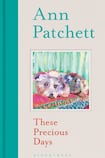
“People are not characters, no matter how often we tell them they are; conversations are not dialogue; and the actions of our days don’t add up to a plot. In life, time runs along in its sameness, but in fiction time is condensed – one action springboards into another, greater action. Cause and effect are so much clearer in novels than in life.”
In her new collection of essays, Ann Patchett dispenses wisdom on the differences between life and art with the precision and ease of an old hand, someone who is entirely comfortable in her own skin and confident in her ability as both artist and human being. This will hardly come as a surprise to fans of the American author of seven novels and three works of nonfiction.
The Dutch House, Patchett’s most recent novel, was longlisted for the 2020 Women’s Prize. In 2002 she won the Orange Prize for Fiction with Bel Canto, with two further shortlistings for the award in 2012 and 2018 respectively. She has also received the PEN/Faulkner Award, and her work has been translated into more than 30 languages. And her life beyond writing is well known, not least the fact that she co-owns a bookshop, Parnassus Books, in Nashville.
For all her artistic achievements, Patchett retains a certain humility in her writing, which gives it universal resonance and wide appeal
Patchett’s personal essays have appeared in publications such as the New Yorker, the New York Times and Harpers Bazaar. Indeed most of the 22 essays that comprise her new collection have been published elsewhere over the last two decades, though re-reading writing of this quality is no hardship either. These Precious Days is an illuminating, engaging collection that gives a portrait of the artist over decades, the roles and relationships that have sustained her, and the lessons learned, which she passes on to readers in her sometimes stark, sometimes softly funny style.
For all her artistic achievements, Patchett retains a certain humility in her writing, which gives it universal resonance and wide appeal. She is like the anti-Jonathan Franzen, never pompous or self-regarding, even while her writing on the American family and way of life matches Franzen’s in perception and storytelling.
While Patchett has been compared to contempories such as Anne Tyler and Jennifer Egan (more recently, Lily King and Katherine Heiny could be added to the list), with this collection of essays, the author who most comes to mind is Jane Smiley, specifically her tome on the craft of fiction writing, Thirteen Ways of Looking at the Novel.
By the end of the book, you crave her company, her career, and perhaps most of all, her talent for living well
In These Precious Days, Patchett frequently uses her own life as a springboard into the work of other writers. Eudora Welty, John Updike and Kate DiCamillo are among those discussed. Virginia Woolf's To the Lighthouse is "the novel that once and forever opened the door of imaginative fiction for me, [I] read it cold, in all its wonder and magnitude".
Lessons in rejection, meanwhile, come from a more unusual source: “Snoopy got far more rejection letters than he ever got acceptances, and the rejections ranged (as they will) from impersonal to flippant to cruel.”
There are universally acknowledged truths: “To be a writer, you have to like your own company.” But there also the stories behind the glitzy headlines: “I got into the Iowa Writers’ Workshop. I didn’t get in anyplace else I applied, nor was I wait-listed anyplace else I applied.” Her own experience and development as a writer is mined over and over again for nuggets. Starting the MFA, “I had been a tender thing when I arrived, and by the end I cared about nothing but writing better stories.”
Her advice to aspiring writers comes from her relationship with her father (the first of three!): “Without ever meaning to, my father taught me at a very early age to give up on the idea of approval. I wish I could bottle that freedom now and give it to every young writer I meet, with an extra bottle for the women.”
Patchett’s family – her curious relationship with her beautiful, thrice-married mother, those fathers, her second husband Karl, and her own decision not to have children – all make for outstanding individual essays. Other highlights include an analysis of book covers, the long title essay about her remarkable friend Sooki, and a piece on backpacking around Europe as a college student, which saw Patchett visit Northern Ireland in the 1980s: “I can hardly remember seeing a boy without a tattoo that summer, or, for that matter, a boy without a gun.”
By the end of the book (but also right from the beginning), you crave her company, her career, and perhaps most of all, her talent for living well. These essays are at once a timely reminder that the days are precious – and a how-to guide for making them so.












